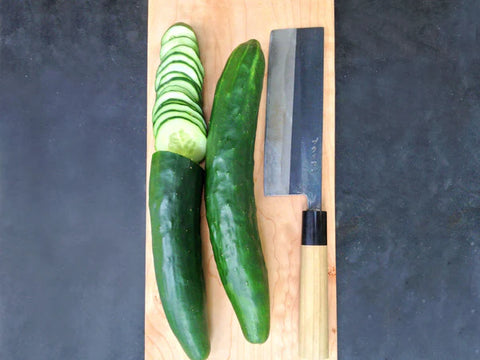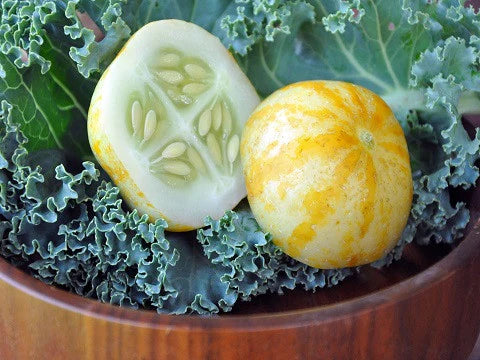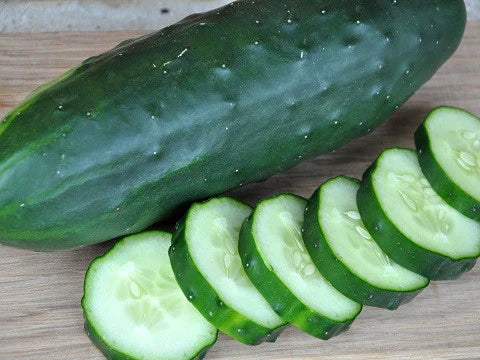Step into the delightful realm of cucumber cultivation! Whether you're a seasoned "cuke" enthusiast or a newbie to the world of "cukettes," this guide will teach you everything you need to know about growing and using cucumbers.
Pictured: Chicago Pickling Cucumber (click for seeds)
🥒 Origins of Cucumbers
These rejuvenating and crunchy garden treasures trace their roots back to India. Cucumbers were introduced to America from India through global trade and exploration, with European merchants and explorers bringing these prized vegetables to the New World during the colonial period.
Cultivating cucumbers in the Midwest is quite a different climate and demands some unique attention and effort, but it's a more manageable endeavor than you might imagine. With the invaluable insights provided in this comprehensive guide to cucumber cultivation, you'll be well-prepared to embark on your journey to master the art of growing cucumbers!
Why Grow Cucumbers?
Here are some reasons why cucumbers are awesome and why you should grow them:
- They’re nutritious: Although for many years, cucumbers were thought of as a “diet” food, they actually contain important phytonutrients.
- They are easy to preserve using traditional fermentation methods, commonly called “pickling!” It’s as easy as adding cucumbers, salt, and water to a mason jar and waiting.
- They’re cool and refreshing on a hot summer day!
Pictured: Green Finger Cucumber (click for seeds)
Types of Cucumbers
As with most things, the species “Cucumis sativus” exists along a spectrum; there are huge, torpedo-like cucumbers, small, yellow ones, bumpy and spiny pickling varieties, and long, thin Asian types. But here are the two categories you’ll most likely see in seed catalogs.

“Slicer cucumbers”: These are the more common types of cucumbers that so many eaters are familiar with. They tend to be on the larger and longer side and are used more for salads or cooking rather than pickling.
Pickling cucumber types: `Pickling cucumbers are usually smaller varieties commonly preserved as pickles but are often great in salads, too!
 Pictured: Lemon cucumber (click for seeds)
Pictured: Lemon cucumber (click for seeds)
Growing Cucumbers: Starting Seeds
Growing Cucumbers Inside:
Cucumbers do not like their roots disturbed during transplanting, so if you’re starting seeds indoors, use biodegradable pots.
- Start seeds indoors 5/1 into a good seed starting mix (we recommend Vermont Compost’s Fort Light). Sow 3-4 seeds ½” deep in each pot.
- The ideal temperature for germination is 75-95℉ (Use a heating mat or place them on top of the fridge for extra heat).
- Cucumber seedlings are sensitive to damping off fungus, so keep the soil lightly moist but not too wet and use a fan (set to low) to provide air circulation.
- Once two leaves appear, grow plants at 72℉ and snip off (don’t pull) all but the most vigorous seedling from each pot.
- Transplant outdoors around 6/1 when warm temperatures have settled in.
Growing Cucumbers Outside:
Direct sow seeds outdoors around 6/1. Sow seeds ½” deep. b) Sow seeds in patches or rows.
- Patches: sow 2-3 seeds per patch with patches spaced 1 foot apart (plant to thin plants to 1 plant per patch)
- Rows: sow two seeds per foot in rows 3 feet apart; plan to thin plants to plant per foot
Transplanting Cucumbers Outdoors
- Hardening off your plants: For 1-2 weeks before transplanting, start hardening off your plants.
- Put them outdoors for gradually longer increments of time during the day, beginning with 15 minutes the first day, 30 minutes the second, etc.
- Observe how your cucumbers look after putting them outside each time to determine how long you should keep them out the next day. If they look wilted after 30 minutes, go back to 15. Use your best judgment.
- Transplant cucumber seedlings outdoors (plant the entire biodegradable pot into the soil) around 6/1 into fertile soil with lots of compost or decomposed manure. Water seedlings after planting.
- For an extra boost, foliar feed young cucumber plants one week after transplanting with fish/seaweed fertilizer.
Pictured: Poinsett 76 Cucumber (click for seeds)
Cucumber Growing Tips
🐛 Cucumber Pests and Diseases:
- Protect seedlings from slugs - we use Sluggo at planting time.
- Protect plants from deer and groundhogs.
- Protect seedlings from cucumber beetles by covering plants with row cover fabric at planting and leaving it on until plants are flowering.
- Inspect plants regularly, handpick off any cucumber beetles, and shake them into a jar of soapy water.
- Use “crop rotation” to minimize pests and diseases
- Minimize the spread of disease by not handling wet vines.
💧 Cucumber Watering:
Water your cucumbers well! Remember how juicy and, crisp and watery their fruit is? Well, that water has to come from somewhere. Underwatered cucumbers will likely be tasteless and bitter.
🥒 Cucumber Harvesting:
Harvest cucumbers regularly to maximize production, picking the fruit once it’s reached its characteristic green color. Younger fruit from slicing cucumbers can be harvested when even smaller, especially for pickles. Gently twist or clip off cucumbers; be careful not to break the vines.
Cucumber Storage:
Cucumbers keep refrigerated for 1-2 weeks, but pickling is the best method for long-term storage. Check out our Guide to Live Fermentation.
Seed Saving Cucumbers are insect-pollinated and cross-pollinated. They will cross with any cucumber varieties within ½ mile. You can always save seed and see what you get! Allow cucumber fruit to mature fully (they will be large, hard, and yellow/orange). Scoop out the seed, rinse, and dry on a screen. Note that the minimum population size is 6-25 plants.
Cucumber Recipes:
Ready to start using your cucumbers? Check out these cucumber recipes on our website to try these delicious dishes!
- Erica’s Summer Salad
- Mizeria (Polish Cucumber Salad)
- Sesame Kale Amaranth Cucum
Click here to read a PDF copy of this guide.



